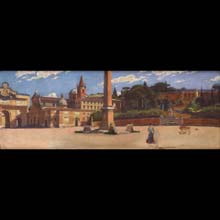
material: oil on canvas
dimensions: 39,5 × 105 cm
description: Gierymski’s process of painting was almost always long and laborious. Work in the atelier was always preceded by the observation of the motif in the open air, which enabled the artist to capture the fleeting effects of light and colour. The finished work was sometimes characterized by laboured stiffness, far from the lightness represented by preparatory studies. In the last, Roman period, the artist painted views of many squares and streets of the Eternal City. They included Piazza del Popolo, an imposing urban layout with an Egyptian obelisk in the centre. From the north, the square is approached by Via Flaminia. Upon going through the gate called Porta del Popolo, one can see the view of the junction of three streets: Via Babuino, Via della Ripetta and Via del Corso, whose beginning is marked with two, almost identical churches: Santa Maria dei Miracoli and Santa Maria dei Montesanto. This work is an oil sketch for the final composition, now in the collection of the National Museum in Warsaw. A considerably elongated, horizontal format gives the scene a panoramic effect, while the spaciousness of the landscape has been flattened as a result of selecting this particular view. The vertical axis of the composition is marked by the central obelisk. The foreground is occupied by the paved surface of the square with a random woman walking through it. The background features buildings and a stand overgrown with grass. The view strikes with the artist’s cool, analytical attitude to the depicted motif. At the same time the viewer can feel the artist’s unusual sensitivity to the effects of colour and light. Contrary to the finished composition, executed meticulously using a technique resembling pointillism, this sketch was painted with synthetic, fluidly applied colour, with special attention paid to highlighting forms using contours, visible especially in the area of the architecture. Aleksandra Krypczyk
exposition: The Gallery of 19th Century Polish Art in Sukiennice,
The Cloth Hall, 1, Main Market Square
key: Realism, polish impressionism, beginnings of symbolism >>>
dimensions: 39,5 × 105 cm
description: Gierymski’s process of painting was almost always long and laborious. Work in the atelier was always preceded by the observation of the motif in the open air, which enabled the artist to capture the fleeting effects of light and colour. The finished work was sometimes characterized by laboured stiffness, far from the lightness represented by preparatory studies. In the last, Roman period, the artist painted views of many squares and streets of the Eternal City. They included Piazza del Popolo, an imposing urban layout with an Egyptian obelisk in the centre. From the north, the square is approached by Via Flaminia. Upon going through the gate called Porta del Popolo, one can see the view of the junction of three streets: Via Babuino, Via della Ripetta and Via del Corso, whose beginning is marked with two, almost identical churches: Santa Maria dei Miracoli and Santa Maria dei Montesanto. This work is an oil sketch for the final composition, now in the collection of the National Museum in Warsaw. A considerably elongated, horizontal format gives the scene a panoramic effect, while the spaciousness of the landscape has been flattened as a result of selecting this particular view. The vertical axis of the composition is marked by the central obelisk. The foreground is occupied by the paved surface of the square with a random woman walking through it. The background features buildings and a stand overgrown with grass. The view strikes with the artist’s cool, analytical attitude to the depicted motif. At the same time the viewer can feel the artist’s unusual sensitivity to the effects of colour and light. Contrary to the finished composition, executed meticulously using a technique resembling pointillism, this sketch was painted with synthetic, fluidly applied colour, with special attention paid to highlighting forms using contours, visible especially in the area of the architecture. Aleksandra Krypczyk
exposition: The Gallery of 19th Century Polish Art in Sukiennice,
The Cloth Hall, 1, Main Market Square
key: Realism, polish impressionism, beginnings of symbolism >>>












